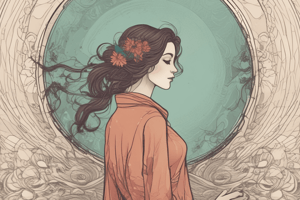Podcast
Questions and Answers
What are assets classified into?
What are assets classified into?
- Fixed and variable assets
- Current and long-term assets
- Short-term and long-term assets
- Current and non-current assets (correct)
What are the characteristics of current assets?
What are the characteristics of current assets?
- Expected to be converted into cash within one year or within the company's normal operating cycle and are highly liquid (correct)
- Expected to be used for more than one year and are highly liquid
- Expected to be converted into cash beyond the company's normal operating cycle and are not liquid
- Expected to be used for more than one year and are not liquid
What is the main characteristic of non-current liabilities?
What is the main characteristic of non-current liabilities?
- Expected to be paid or settled within one year or within the company's normal operating cycle
- Expected to be paid or settled more than one year or beyond the company's normal operating cycle (correct)
- Expected to be converted into cash within one year or within the company's normal operating cycle
- Expected to be used for more than one year
What does equity represent in a business?
What does equity represent in a business?
What is the formula for calculating the current ratio?
What is the formula for calculating the current ratio?
What does a higher current ratio indicate?
What does a higher current ratio indicate?
What are examples of current liabilities?
What are examples of current liabilities?
What are examples of non-current assets?
What are examples of non-current assets?
Why do current liabilities require immediate attention?
Why do current liabilities require immediate attention?
What happens to equity when a company makes a profit?
What happens to equity when a company makes a profit?
Flashcards are hidden until you start studying
Study Notes
Assets
- Resources owned or controlled by a business
- Expected to generate future economic benefits
- Classified into:
- Current assets: expected to be converted into cash or used up within one year or within the company's normal operating cycle
- Non-current assets: expected to be used for more than one year or beyond the company's normal operating cycle
Current Assets
- Examples:
- Cash
- Accounts receivable (amounts customers owe the company)
- Inventory
- Prepaid expenses
- Short-term investments
- Characteristics:
- Expected to be converted into cash within one year or within the company's normal operating cycle
- Highly liquid
Liabilities
- Debts or obligations that a business must pay or settle
- Classified into:
- Current liabilities: expected to be paid or settled within one year or within the company's normal operating cycle
- Non-current liabilities: expected to be paid or settled more than one year or beyond the company's normal operating cycle
Current Liabilities
- Examples:
- Accounts payable (amounts the company owes to suppliers)
- Short-term loans
- Accrued expenses (salaries, taxes, etc.)
- Unearned revenue
- Characteristics:
- Expected to be paid or settled within one year or within the company's normal operating cycle
- Require immediate attention
Non-Current Liabilities
- Examples:
- Long-term loans
- Bonds
- Mortgage loans
- Characteristics:
- Expected to be paid or settled more than one year or beyond the company's normal operating cycle
- Do not require immediate attention
Equity
- Represents the ownership interest in a business
- Also known as net worth or shareholders' equity
- Increases when the company makes a profit and decreases when the company incurs a loss
Current Ratio
- Calculated by dividing current assets by current liabilities
- Formula: Current Ratio = Current Assets / Current Liabilities
- Interpreted as:
- A higher ratio indicates a higher liquidity and ability to pay short-term debts
- A lower ratio indicates a lower liquidity and ability to pay short-term debts
Assets
- Resources owned or controlled by a business, expected to generate future economic benefits
- Classified into:
- Current assets: expected to be converted into cash or used up within one year or within the company's normal operating cycle
- Non-current assets: expected to be used for more than one year or beyond the company's normal operating cycle
Current Assets
- Examples: cash, accounts receivable, inventory, prepaid expenses, short-term investments
- Characteristics: expected to be converted into cash within one year or within the company's normal operating cycle, highly liquid
Liabilities
- Debts or obligations that a business must pay or settle
- Classified into:
- Current liabilities: expected to be paid or settled within one year or within the company's normal operating cycle
- Non-current liabilities: expected to be paid or settled more than one year or beyond the company's normal operating cycle
Current Liabilities
- Examples: accounts payable, short-term loans, accrued expenses, unearned revenue
- Characteristics: expected to be paid or settled within one year or within the company's normal operating cycle, require immediate attention
Non-Current Liabilities
- Examples: long-term loans, bonds, mortgage loans
- Characteristics: expected to be paid or settled more than one year or beyond the company's normal operating cycle, do not require immediate attention
Equity
- Represents the ownership interest in a business
- Also known as net worth or shareholders' equity
- Increases when the company makes a profit and decreases when the company incurs a loss
Current Ratio
- Calculated by dividing current assets by current liabilities
- Formula: Current Ratio = Current Assets / Current Liabilities
- Interpretation:
- Higher ratio: higher liquidity and ability to pay short-term debts
- Lower ratio: lower liquidity and ability to pay short-term debts
Studying That Suits You
Use AI to generate personalized quizzes and flashcards to suit your learning preferences.





